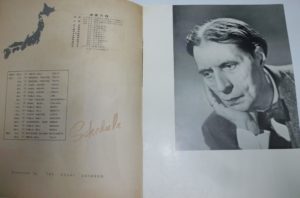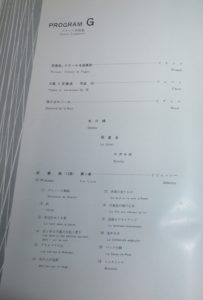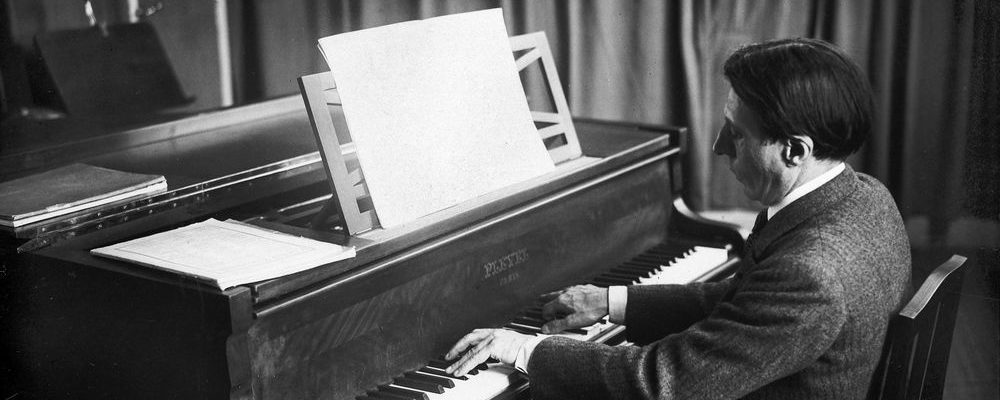Alfred Cortot’s name is sometimes uttered with disdain for his technical ability at the keyboard. It is indeed a fact that some of Cortot’s performances have wrong notes, something that our sanitized ears today are not used to in an age of digital editing and soulless perfection aimed more at satisfying competition juries than touching the heart of a listener. Certainly one need not aim for wrong notes in order to imbue a performance with passion, but if in the heat of the moment a performer misses a note, should the interpretation be discounted and the pianist’s skill be called into question? I think not.
As was clearly articulated in Harold C Schonberg’s classic tome ‘The Great Pianists’, Cortot was an active teacher, school administrator, active performer, and prolific recording artist – with all this on his plate, how much time did he have to practice? There is no doubt as to his well-grounded technical capacity when one merely glances at his book of piano exercises, ‘Principes Rationnels de la Technique Pianistique’, or his study editions for great keyboard works of Chopin, Schumann, and Liszt, which contain brilliant exercises designed to make performances of these works easier on a physical level (in addition to adding great insight on other levels of awareness).
Indeed, Cortot’s digital dexterity was so brilliant that Horowitz made a trip to Paris hoping to learn the French master’s fingering for the treacherous ‘Etude en Forme de Valse’ of Saint-Saens, his 1919 recording of which the young Russian pianist had heard. (Cortot did not tell him.) Here is that amazing performance:
Unfortunately, while one can appreciate the great Cortot’s digital wizardry, there is less of an opportunity to recognize the beauty of his tone in these early recordings, which were made using the acoustical recording process (whereby a cone-shaped horn as opposed to a microphone captured the performance). From 1925, recording techniques improved considerably (microphones came into use), and in 1931 Cortot recorded the same work again – still brilliant fingerwork, though perhaps not quite as seamless, but with that gorgeous, rich mahogany tone that is instantly recognizable:
Despite a few splashy moments, the performance is brilliant on many levels. One accepts Cortot’s wrong notes, as Schonberg wrote, ‘as one accepts scars or defects in a painting by an old master’: it is worth experiencing a work of art so beautifully expressed even if there are a few superficial flaws.
In the 1930s, Cortot recorded a great many of Chopin’s works, among them the Sonatas, Etudes, Waltzes, and Impromptus. His recording of the Third Impromptu – hardly the most commonly played of Chopin’s works – has always struck me as one of his greatest and as the most successful of the work, with soaring phrasing, remarkably fluid timing that fits with the structure of the unusual figurations, and a varied tonal palette. This is the kind of playing that reflects the depth of Cortot’s essence:
Cortot recorded so many of Chopin’s works that one has the mistaken impression that he recorded them all. But while he recorded the Sonatas, Etudes, Preludes, and Waltzes multiple times over the course of three decades, in addition to a few other works, he did not record the complete Scherzi, Polonaises, or Nocturnes (Artur Rubinstein did) – although according to one discographer he made attempts at all of the Scherzi and Polonaises in the 1940s and the complete Nocturnes in the 1950s. My source at EMI France – a great Cortot fan himself – assures me that no traces of any of these exist in the archives.
 Which brings us to the point of this post: a rare recording made in his twilight years while on tour of Japan of a work he regrettably did not record earlier. In 1952, Cortot gave an extensive tour of Japan that involved 18 performances in 13 cities, with four different programs. These photos of the elegant program booklet (photos copyrighted – credits at bottom of post) show that among the works he played was Gaspard de la Nuit, a work of which no Cortot recording has been found. (He did in fact record it at the same 1939 EMI session that brought us the wonderful Weber Second Sonata, but it was never
Which brings us to the point of this post: a rare recording made in his twilight years while on tour of Japan of a work he regrettably did not record earlier. In 1952, Cortot gave an extensive tour of Japan that involved 18 performances in 13 cities, with four different programs. These photos of the elegant program booklet (photos copyrighted – credits at bottom of post) show that among the works he played was Gaspard de la Nuit, a work of which no Cortot recording has been found. (He did in fact record it at the same 1939 EMI session that brought us the wonderful Weber Second Sonata, but it was never  issued, the masters have been destroyed, and no copies have been located.) Apparently it was obvious to even the less musical listeners that the treacherous ‘Gaspard’ was beyond the aging pianist’s capacity, though it would still be fascinating to hear if a broadcast recording were ever to turn up.
issued, the masters have been destroyed, and no copies have been located.) Apparently it was obvious to even the less musical listeners that the treacherous ‘Gaspard’ was beyond the aging pianist’s capacity, though it would still be fascinating to hear if a broadcast recording were ever to turn up.
 During this visit, Cortot spent two days at RCA Victor’s studios in Tokyo making a series of records that were only issued in that country. There is no doubt that he was past his prime, and the recordings feature playing with less cohesiveness than his earlier performances, but there is some value to be found in some of them. This series of discs has been issued twice on CD in Japan, the more recent issue featuring fine transfers from the original source material, and has only just recently been made available in the West in a 40-disc Anniversary Edition on EMI. Of particular interest is Cortot’s recording of Chopin’s Second Scherzo, which despite a few splashy moments and occasionally less fluid phrasing than was his norm at his peak, features some very poetic playing and gives us an idea of how he might have played the work in his younger years. (The Third Scherzo, sadly, is tough even for Cortot admirers to sit through.)
During this visit, Cortot spent two days at RCA Victor’s studios in Tokyo making a series of records that were only issued in that country. There is no doubt that he was past his prime, and the recordings feature playing with less cohesiveness than his earlier performances, but there is some value to be found in some of them. This series of discs has been issued twice on CD in Japan, the more recent issue featuring fine transfers from the original source material, and has only just recently been made available in the West in a 40-disc Anniversary Edition on EMI. Of particular interest is Cortot’s recording of Chopin’s Second Scherzo, which despite a few splashy moments and occasionally less fluid phrasing than was his norm at his peak, features some very poetic playing and gives us an idea of how he might have played the work in his younger years. (The Third Scherzo, sadly, is tough even for Cortot admirers to sit through.)
Listening to this performance might make us wish that he had recorded it a couple of decades earlier – hearing the Third Impromptu above gives us insight into how he might have played this Scherzo in the 1930s. How wonderful nevertheless to be able to hear him in this work, even if his playing was a shadow of his former glory.
To leave with a perhaps more unified impression of his art, here is what might be the last solo recording that exists of the artist: a 1957 Munich radio broadcast of Chopin’s Berceuse Op.57, in which his rich, penetrating tone and evocative pedalling help him create a truly wonderful dream world.
Photos of Japanese concert programme courtesy of Sumie Ueno, retired seasonal lecturer from the Osaka College of Music. Program courtesy of Hiroshi Fukuda, Professor Emeritus from Hiroshima Prefectural Women’s University. Thanks to Chihiro Homma for making these available for this posting.
